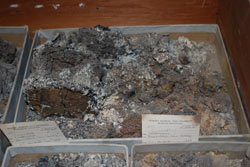Pyrite "Disease"
 Pyrite (or iron persulfide: FeS2), also known as “fool’s gold,” is a common mineral that is often found in sedimentary rock. In some fossil deposits pyrite gets incorporated into bone, invertebrate shell, and plant fossils during the process of fossilization. If these fossils are exposed to conditions of high humidity, “pyrite disease” (also known as pyrite “rot” or “decay”) can occur.
Pyrite (or iron persulfide: FeS2), also known as “fool’s gold,” is a common mineral that is often found in sedimentary rock. In some fossil deposits pyrite gets incorporated into bone, invertebrate shell, and plant fossils during the process of fossilization. If these fossils are exposed to conditions of high humidity, “pyrite disease” (also known as pyrite “rot” or “decay”) can occur.
The mineral oxidizes and forms iron sulphate (FeSO4); this oxidation product is several times the volume of the original mineral and the resulting crystal growth and expansion causes the specimen to fracture and crumble. The best way to combat this problem is by good “preventive conservation” focusing on keeping fossils in dry conditions – under 45% RH - is the only way to prevent this deterioration. Once the damage begins it is irreversible and specimens should then be kept in RH under 30%. While there are some remedial treatments, and more information can be obtained on these in the references below, good storage practices are the most efficient route for preservation.
For an example of what can happen to fossils with pyrite disease click here to visit the website of the Triceratops project at the Smithsonian Institution’s National Museum of Natural History where pyrite oxidation was one of the reasons that the fossil skeleton was removed from display.
For more on this subject see:
- Pyrite oxidation: Review and Prevention, by Akiko Shinya and Lisa Bergwall, a poster presented at the 2007 Society of Vertebrate Paleontology annual meeting and available for viewing at practices
- Pyrite Preservation by Sally Shelton in the Knoxville Gem and Mineral Society KGeMS Volume XXXII, Issue 2 from February 2001 p. 8
- Sections U:7 and U8 of the National Park Service Museum Handbook Part I.
- Collins, Chris. 1995. Care and Conservation of Paleontological Material. Boston: Butterworth-Heinemann.

